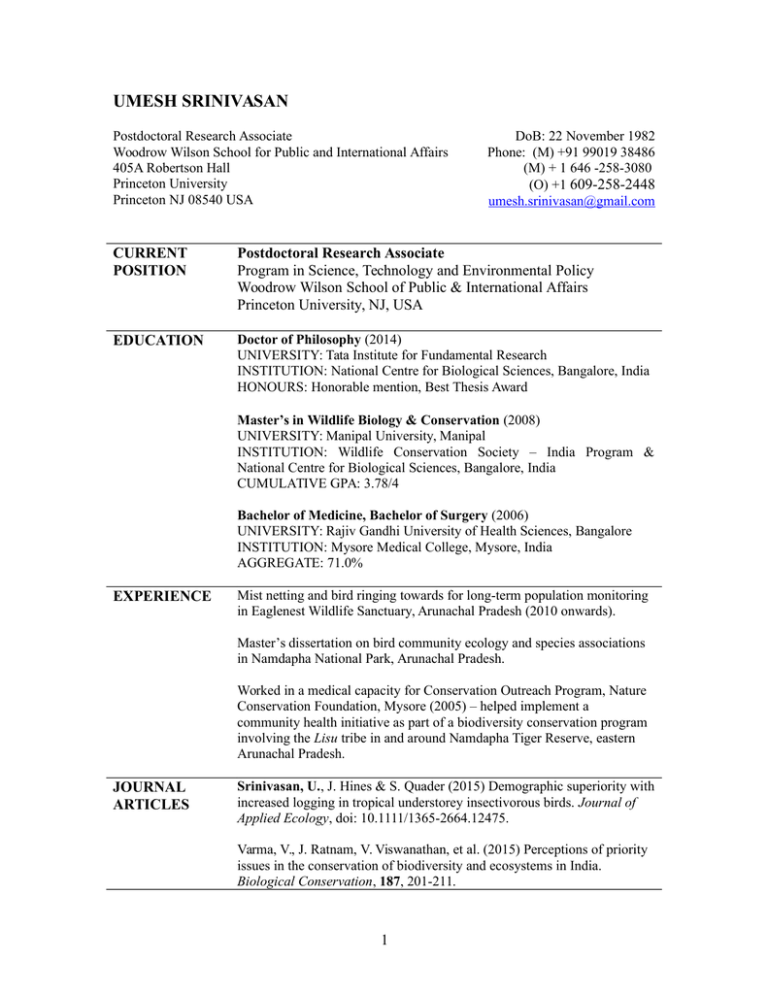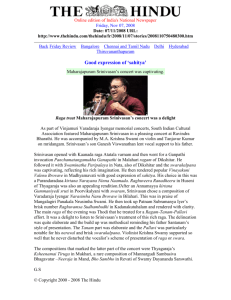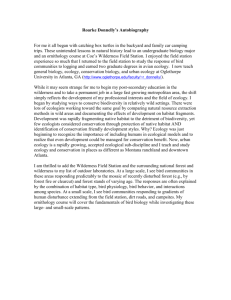UMESH SRINIVASAN
advertisement

UMESH SRINIVASAN Postdoctoral Research Associate Woodrow Wilson School for Public and International Affairs 405A Robertson Hall Princeton University Princeton NJ 08540 USA DoB: 22 November 1982 Phone: (M) +91 99019 38486 (M) + 1 646 -258-3080 (O) +1 609-258-2448 umesh.srinivasan@gmail.com CURRENT POSITION Postdoctoral Research Associate Program in Science, Technology and Environmental Policy Woodrow Wilson School of Public & International Affairs Princeton University, NJ, USA EDUCATION Doctor of Philosophy (2014) UNIVERSITY: Tata Institute for Fundamental Research INSTITUTION: National Centre for Biological Sciences, Bangalore, India HONOURS: Honorable mention, Best Thesis Award Master’s in Wildlife Biology & Conservation (2008) UNIVERSITY: Manipal University, Manipal INSTITUTION: Wildlife Conservation Society – India Program & National Centre for Biological Sciences, Bangalore, India CUMULATIVE GPA: 3.78/4 Bachelor of Medicine, Bachelor of Surgery (2006) UNIVERSITY: Rajiv Gandhi University of Health Sciences, Bangalore INSTITUTION: Mysore Medical College, Mysore, India AGGREGATE: 71.0% EXPERIENCE Mist netting and bird ringing towards for long-term population monitoring in Eaglenest Wildlife Sanctuary, Arunachal Pradesh (2010 onwards). Master’s dissertation on bird community ecology and species associations in Namdapha National Park, Arunachal Pradesh. Worked in a medical capacity for Conservation Outreach Program, Nature Conservation Foundation, Mysore (2005) – helped implement a community health initiative as part of a biodiversity conservation program involving the Lisu tribe in and around Namdapha Tiger Reserve, eastern Arunachal Pradesh. JOURNAL ARTICLES Srinivasan, U., J. Hines & S. Quader (2015) Demographic superiority with increased logging in tropical understorey insectivorous birds. Journal of Applied Ecology, doi: 10.1111/1365-2664.12475. Varma, V., J. Ratnam, V. Viswanathan, et al. (2015) Perceptions of priority issues in the conservation of biodiversity and ecosystems in India. Biological Conservation, 187, 201-211. 1 Velho, N., U. Srinivasan, P. Singh & W.F. Laurance (2015) Large mammal use of protected and community-managed lands in a biodiversity hotspot. Animal Conservation, doi: 10.1111/acv.12234. Srinivasan, U. (2014) Oil palm expansion: ecological threat to north-east India. Economic and Political Weekly, XLIX, Sep. 06, 2014. Velho, N., M. Agarwala, U. Srinivasan & W.F. Laurance (2014) Collateral damage: impacts of ethno-civil strife on biodiversity and natural resource use near Indian nature reserves. Biodiversity and Conservation, 23, 25152527. Srinivasan, U., K. Tamma & U. Ramakrishnan (2014). Species ecology and past climate drive nested species richness patterns along an east-west axis in the Himalaya. Global Ecology & Biogeography, 23, 52-60. Srinivasan, U. (2013). A slippery slope: logging alters mass-abundance relationships in ecological communities. Journal of Applied Ecology, 50, 920-928. Sridhar, H., U. Srinivasan, et al. (2012). Positive relationships between association strength and phenotypic similarity characterize the assembly of mixed-species flocks wordwide. The American Naturalist, 180, 777-790. Srinivasan, U. & S. Quader (2012). To eat and not be eaten: modelling resources and safety in multi-species animal groups. PloS One, e42071. Srinivasan, U., R.H. Raza & S. Quader (2012). Patterns of species participation across multiple mixed-species flock types in a tropical forest in northeastern India. Journal of Natural History, 46, 2749-2762. Velho, N., J. Ratnam, U. Srinivasan & M. Sankaran (2012). Shifts in community structure of tropical trees and avian frugivores in forests recovering from past logging. Biological Conservation, 153, 32-40. Krishnadas, M., N. Velho & U. Srinivasan (2012) The worrisome business of the National Investment Board. Economic and Political Weekly, XLVII, 13-17. Velho, N., M. Krishnadas, S. Sridhara & U. Srinivasan (2012) Turning the page in wildlife science: conservation biology and bureaucracy. Economic and Political Weekly, XLVII, 27-29. Velho, N., U. Srinivasan, Prashanth N.S. & W.F. Laurance (2011). Human disease hinders anti-poaching efforts in Indian nature reserves. Biological Conservation, 144, 2382-2385. Krishnadas, M., U. Srinivasan, N. Velho & S. Sridhara (2011) Turning the page in forest governance: science and bureaucracy. Economic and Political Weekly, XLVI, 10-13. 2 Srinivasan, U., R. H. Raza & S. Quader (2010). The nuclear question: rethinking species importance in multi-species animal groups. Journal of Animal Ecology, 79, 948-954. Srinivasan, U., S. Dalvi, R. Naniwadekar, M.O. Anand & A. Datta (2010) The birds of Namdapha National Park and surrounding areas: recent significant records and a checklist of the species. Forktail, 26, 92-116. Srinivasan, U., S. Dalvi & K. Yobin (2009) First records of ‘white-headed’ Black Bulbul Hypsipetes leucocephalus from India. Indian Birds, 5, 28-30. Srinivasan, U. and Prashanth N.S. (2006). Preferential routes of bird dispersal to the Western Ghats in India: An explanation for the avifaunal peculiarities of the Biligirirangan Hills. Indian Birds. 2, 114-119. Srinivasan, U. and Prashanth N.S. (2005) Additions to the avifauna of the Biligirirangan Hills, Karnataka. Indian Birds, 1, 103-104. POPULAR WRITING Srinivasan, U. (2014) Tree shrews: BRT, and a little beyond. www.JLRexplore.com, Sep. 01. Srinivasan, U. & N. Velho (2014) Land of the Liocichla. Saevus, Jan. 15. Srinivasan, U (2012) India Inc.’s new bogey. Down to Earth, Nov. 30. Velho, N. & U. Srinivasan (2011) Dont just cash in on tigers. Nature based tourism: from rhetoric to reality. Down to Earth, Dec. 15. Srinivasan, U (2011) Soliga welfare or tiger conservation? (In Kannada). Vijaya Karnataka. Velho, N. & U. Srinivasan (2010) Survey proposes study of Naroa’s habitats. The Herald. Srinivasan, U. & N. Velho(2009) Science the scapegoat: the curious case of the extinction of tigers in Panna. Sanctuary Asia Magazine, 1109: 7677. COURSES AND WORKSHOPS Community Ecology, Master's Program in Wildlife Biology and Conservation, National Centre for Biological Sciences, Tata Institute of Fundamental Research, Bangalore (June-July 2015) Data visualisation and graphics in R. Young Ecologists Talk and Interact 2013, Nagaland University (December 2013) Basic R for ecologists. Young Ecologists Talk and Interact 2013, Nagaland University (December 2013) Data visualisation and graphics in R. Students’ Conference on 3 Conservation Science 2013, Bangalore (September 2013) Bird census and sampling techniques. Volunteer Training Programme, Karnataka Ecotourism Development Board (August, September 2013) R for ecologists: getting started. Ashoka Trust for Research in Ecology and the Environment, Bangalore (August 2013) Advanced R and advanced statistics. Students’ Conference on Conservation Science 2012, Bangalore (August 2012) R for ecologists. Young Ecologists Talk and Interact 2011, Guwahati (December 2011) Basic R for ecologists. Post-graduate Programme in Wildlife Biology and Conservation, National Centre for Biological Sciences (September 2010) INVITED TALKS The Principal Components Analysis. Ashoka Trust for Research in Ecology and the Environment, Bangalore (March 2014) Logging impacts on understorey birds. Centre for Ecological Sciences, Indian Institute of Science, Bangalore (February 2014) Logging impacts on understorey birds. Ashoka Trust for Research in Ecology and the Environment, Bangalore (February 2014) Ethno-civil strife, armed insurgency and biodiversity conservation in northeast India. Nehru Memorial Museum and Library, New Delhi (May 2013) Coalition politics in the animal kingdom. Young Ecologists Talk and Interact 2012, Dehradun (December 2012) Demographic responses of understorey birds to logging. Centre for Tropical Ecology & Sustainability Science, James Cook University (Cairns campus), Australia (October 2012) Counting birds. Mount Carmel College, Bangalore (July 2011) Birds of northeast India. Rotary Club, Bangalore (July 2011) Bird census and monitoring techniques. Department of Science and Technology, Government of India, Guwahati (February 2009) Bird studies in northeast India. Department of Science and Technology, Government of India, Guwahati (February 2009) GRANTS International Foundation for Science grant (2012) for research on the demographic impacts of logging on understorey bird populations. 4 Rufford Small Grant for Nature Conservation for a project on communitybased bird conservation (2009). Project title: An avifaunal survey of Namdapha National Park: exploring the potential for limited bird tourism with local communities. HONOURS Honorable Mention, The TAA-Zita Lobo Best Thesis Award in Biological Scienes. Tata Institute of Fundamental Research, Mumbai (2014) Best talk award for 'Demographic impacts of logging on understorey bird species' at the Students' Conference on Conservation Science, Bangalore, India (2012) Madhav Gadgil award for best oral presentation on ‘Species associations in mixed-species bird flocks’ at the conference of the Association for Tropical Biology and Conservation (Asia-Pacific Chapter), Chiang Mai, Thailand (2009) Ranked 1st overall in all semesters of Post-Graduate Program in Wildlife Biology and Conservation, with a cumulative GPA of 3.78/4 (2008) Best Outgoing Student (Academic): MBBS Batch of 2000, Mysore Medical College, Mysore with an aggregate of 71.0 % (2006) REVIEWER FOR Animal Conservation, Behavioural Ecology, Biological Conservation, Conservation Biology, Current Science, Indian Birds, The Condor 5









